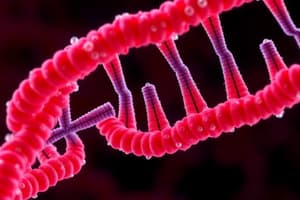Podcast
Questions and Answers
Which enzyme catalyzes the transamination of the amino group of glutamate to anthranilate in the phosphorylation pathway?
Which enzyme catalyzes the transamination of the amino group of glutamate to anthranilate in the phosphorylation pathway?
Anthranilate synthase (TrpE)
What are the two main pathways for tryptophan biosynthesis in bacteria?
What are the two main pathways for tryptophan biosynthesis in bacteria?
Phosphorylation pathway and Direct Chorismate pathway
What is the first committed step in the phosphorylation pathway of tryptophan synthesis?
What is the first committed step in the phosphorylation pathway of tryptophan synthesis?
Formation of indol-3-pyruvic acid catalyzed by anthranilate-phosphoribosyltransferase (TrpD)
Which enzyme converts indol-3-pyruvic acid into L-tryptophan in the phosphorylation pathway?
Which enzyme converts indol-3-pyruvic acid into L-tryptophan in the phosphorylation pathway?
In the direct chorismate pathway, what is chorismate converted into?
In the direct chorismate pathway, what is chorismate converted into?
Which enzyme catalyzes the conversion of chorismate into prependimine in the direct chorismate pathway?
Which enzyme catalyzes the conversion of chorismate into prependimine in the direct chorismate pathway?
What is the role of the enzyme TrpA in tryptophan synthesis?
What is the role of the enzyme TrpA in tryptophan synthesis?
Describe the function of the TrpR protein in regulating tryptophan operon expression at the transcriptional level.
Describe the function of the TrpR protein in regulating tryptophan operon expression at the transcriptional level.
What is the purpose of the TrpL activator protein in the regulation of tryptophan operon expression?
What is the purpose of the TrpL activator protein in the regulation of tryptophan operon expression?
Explain the concept of feedback inhibition in the context of tryptophan synthesis.
Explain the concept of feedback inhibition in the context of tryptophan synthesis.
What is the significance of the allosteric control mechanism in regulating the activity of the TrpE enzyme?
What is the significance of the allosteric control mechanism in regulating the activity of the TrpE enzyme?
Describe the overall importance of understanding the regulation of tryptophan synthesis in biological systems.
Describe the overall importance of understanding the regulation of tryptophan synthesis in biological systems.
Study Notes
Introduction
The tryptophan operon is a genetic regulatory system responsible for controlling the expression of genes involved in tryptophan synthesis. Tryptophan is an essential amino acid required by living organisms for their growth. This article focuses on the process of tryptophan synthesis within the bacterial Escherichia coli (E. coli) and its regulation through the tryptophan operon.
Tryptophan Synthesis Pathways
Tryptophan biosynthesis in bacteria occurs via two main pathways: one involves phosphorylated intermediates indirectly derived from chorismate using enzymes TrpE, TrpD, and TrpC; the other proceeds directly from chorismate and involves the enzymes TrpB and TrpA. Both pathways require ATP energy input, which can be supplied by either glycolysis or gluconeogenesis.
Phosphorylation Pathway
In this pathway, the amino group of glutamate is transferred to anthranilate via transamination by the enzyme anthranilate synthase (TrpE). Subsequently, the first committed step in the phosphorylation pathway occurs with the formation of indol-3-pyruvic acid catalysed by anthranilate-phosphoribosyltransferase (TrpD). Finally, indol-3-pyruvic acid is converted into L-tryptophan through aldol cleavage and cyclization processes, utilizing the enzyme indol-3-glyceraldehyde pyrophosphokinase (TrpC).
Direct Chorismate Pathway
In the direct chorismate pathway, chorismate is converted into prependimine catalysed by TrpB relying on ATP as a cofactor. Prependimine subsequently undergoes imidazolation by TrpA, generating indoloacetamide. The final step in this pathway involves a C-N bond rearrangement, catalyzed by the enzyme TrpB again, to form L-tryptophan.
Regulation of Tryptophan Operon Expression
In E. coli, the proper regulation of tryptophan synthesis is crucial for the organism's survival. This is achieved through an operon called trp, which encodes the trpE, trpD, and trpC genes involved in the phosphorylation pathway. The trpA gene, encoding the first enzyme (TrpB) in both pathways, is located outside the trp operon.
The expression of the trp operon can be controlled at different levels:
Transcription Level
When the concentration of tryptophan within the cell reaches a threshold level, it binds to two regulatory proteins, the repressor protein TrpR and the activator protein TrpL. In the absence of tryptophan, TrpR binds to the promoter region of the trp operon, preventing transcription into mRNA molecules. When tryptophan is present, it competes with TrpR for binding sites on the DNA, causing a decrease in the association between TrpR and the promoter region. As a result, transcription begins, leading to the production of trpE, trpD, and trpC mRNA.
Post-Transcriptional Level
Another layer of control occurs post-transcriptionally, where TrpE, TrpD, and TrpC are encoded as unstable mRNA species that are susceptible to degradation by RNase I. TrpL enhances their stability against RNase I, ensuring sufficient translation of these mRNAs into functional proteins.
Additionally, the tryptophan biosynthetic enzymes themselves play a role in regulating their own activity. For example, indol-3-glyceraldehyde pyrophosphokinase (TrpC) exhibits feedback inhibition, meaning that its activity decreases as the concentrations of tryptophan or other end products increase. Further, TrpE is subjected to allosteric control by tryptophan, which means that when there is an excess of tryptophan available, this enzyme becomes less active.
Conclusion
Understanding the intricate mechanisms behind tryptophan synthesis helps us appreciate the complexity of biological systems and the ways in which they adapt to changing environmental conditions. By exploring the various pathways responsible for producing this essential amino acid and examining the regulatory processes governing its expression, we gain insights into the fundamental principles governing life.
Studying That Suits You
Use AI to generate personalized quizzes and flashcards to suit your learning preferences.
Description
Explore the genetic regulatory system and biosynthesis pathways involved in tryptophan production in bacteria, focusing on the tryptophan operon within Escherichia coli (E. coli) and the two main synthesis pathways. Learn about the transcriptional and post-transcriptional regulation of tryptophan synthesis enzymes for proper cellular function.




